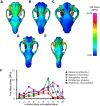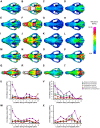Virtual reconstruction and prey size preference in the mid Cenozoic thylacinid, Nimbacinus dicksoni (Thylacinidae, Marsupialia)
- PMID: 24718109
- PMCID: PMC3981708
- DOI: 10.1371/journal.pone.0093088
Virtual reconstruction and prey size preference in the mid Cenozoic thylacinid, Nimbacinus dicksoni (Thylacinidae, Marsupialia)
Abstract
Thylacinidae is an extinct family of Australian and New Guinean marsupial carnivores, comprizing 12 known species, the oldest of which are late Oligocene (∼24 Ma) in age. Except for the recently extinct thylacine (Thylacinus cynocephalus), most are known from fragmentary craniodental material only, limiting the scope of biomechanical and ecological studies. However, a particularly well-preserved skull of the fossil species Nimbacinus dicksoni, has been recovered from middle Miocene (∼16-11.6 Ma) deposits in the Riversleigh World Heritage Area, northwestern Queensland. Here, we ask whether N. dicksoni was more similar to its recently extinct relative or to several large living marsupials in a key aspect of feeding ecology, i.e., was N. dicksoni a relatively small or large prey specialist. To address this question we have digitally reconstructed its skull and applied three-dimensional Finite Element Analysis to compare its mechanical performance with that of three extant marsupial carnivores and T. cynocephalus. Under loadings adjusted for differences in size that simulated forces generated by both jaw closing musculature and struggling prey, we found that stress distributions and magnitudes in the skull of N. dicksoni were more similar to those of the living spotted-tailed quoll (Dasyurus maculatus) than to its recently extinct relative. Considering the Finite Element Analysis results and dental morphology, we predict that N. dicksoni likely occupied a broadly similar ecological niche to that of D. maculatus, and was likely capable of hunting vertebrate prey that may have exceeded its own body mass.
Conflict of interest statement
Figures







References
-
- Krajewski C, Driskell AC, Baverstock PR, Braun MJ (1992) Phylogenetic relationships of the thylacine (Mammalia: Thylacinidae) among dasyuroid marsupials: evidence from cytochrome b DNA sequences. Proc R Soc Lond, Ser B: Biol Sci 250: 19–27. - PubMed
-
- Lowenstein JM, Sarich VM, Richardson BJ (1981) Albumin systematics of the extinct mammoth and Tasmanian wolf. Nature 291: 409–411. - PubMed
-
- Muirhead J, Wroe S (1998) A new genus and species, Badjcinus turnbulli (Thylacinidae: Marsupialia), from the late Oligocene of Riversleigh, northern Australia, and an investigation of thylacinid phylogeny. J Vert Paleontol 18: 612–626.
-
- Sarich V, Lowenstein JM, Richardson BJ (1982) Phylogenetic relationships of the thylacine (Thylacinus cynocephalus, Marsupialia) as reflected in comparative serology. In: Archer M, editor. Carnivorous Marsupials. Sydney: Royal Zoological Society of New South Wales. pp. 445–476.
MeSH terms
LinkOut - more resources
Full Text Sources
Other Literature Sources

